Agricultural Biologicals Market by Function, Product Type (Microbials, Macrobials, Semiochemicals, Natural products), Mode of Application (Foliar Spray, Soil & Seed treatment), Crop Type (Cereals & Grains, Fruits) & Region - Global Forecast to 2028
[359 Pages Report] According to MarketsandMarkets, the agricultural biologicals market is anticipated to reach USD 27.9 billion by 2028 from USD 14.6 billion in 2023, at a CAGR of 13.8% during the forecast period in terms of value. Stricter regulations enforced by governments and regulatory bodies globally aim to safeguard human health and the environment by limiting the use of chemical pesticides. Consequently, there is a growing demand for safer and more sustainable alternatives, driving the increased adoption of agricultural biologicals across the globe.
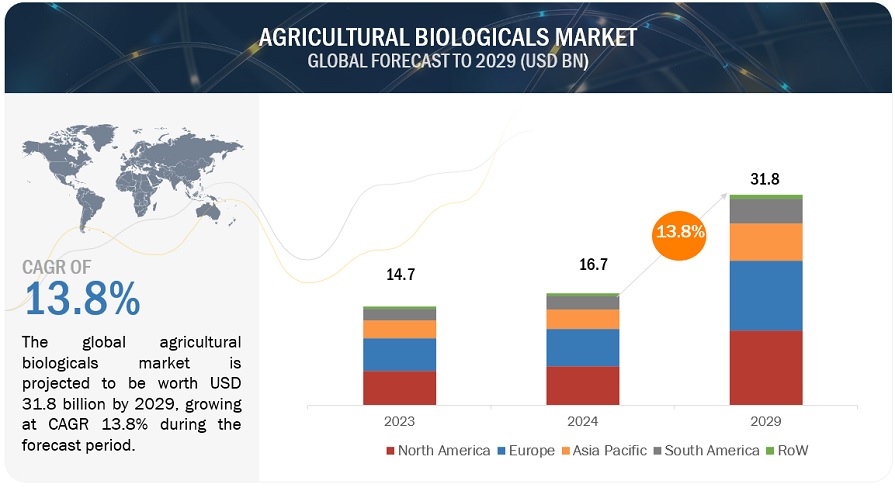
To know about the assumptions considered for the study, Request for Free Sample Report
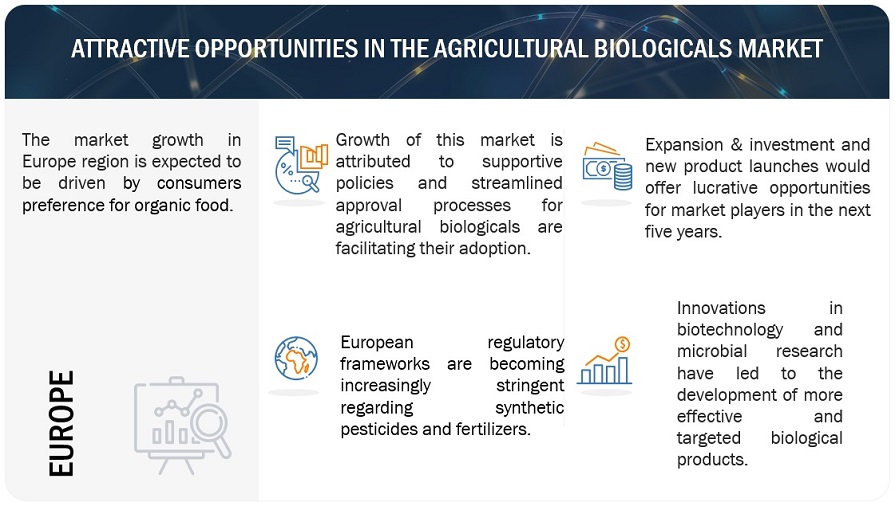
To know about the assumptions considered for the study, download the pdf brochure
Market Dynamics
DRIVER: Stricter Regulations Drive Adoption of Agricultural Biologicals as Sustainable Pesticide Alternatives
Governments and regulatory bodies around the world are increasingly recognizing the potential risks associated with chemical pesticides. These risks include adverse effects on human health, such as pesticide residue on food, as well as environmental concerns, such as contamination of water sources and harm to non-target organisms like beneficial insects and wildlife. To address these concerns, stricter regulations are being implemented to mitigate the use and impact of chemical pesticides.
This regulatory shift has prompted a significant shift in the agricultural industry, with an increasing demand for safer and more sustainable alternatives to conventional chemical pesticides. This demand has led to the rise of agricultural biologicals as viable solutions.
RESTRAINT : Cost Considerations for Agricultural Biologicals: Challenges and Future Prospects
The cost of agricultural biologicals is often higher compared to chemical pesticides due to factors such as higher production costs, limited scalability, and lower market competition. These factors contribute to the relatively higher prices associated with biological products. The production of agricultural biologicals often requires more specialized and intricate processes, which can be costlier than the mass production methods used for chemical pesticides. Additionally, the limited scalability of biological products can result in higher costs as they may not be produced or distributed in as large quantities as chemical pesticides.
However, as the demand for agricultural biologicals continues to rise, the economies of scale are expected to come into play. With increased demand, manufacturers can invest in larger-scale production, leading to cost efficiencies. As more companies enter the market and competition intensifies, there is the potential for price reductions and more competitive pricing for agricultural biologicals. These factors, coupled with advancements in production techniques and formulation technologies, are likely to contribute to a more cost-effective landscape for agricultural biologicals in the future.
Opportunity: The Rise of Integrated Pest Management: Driving Opportunities for Agricultural Biologicals
Integrated Pest Management (IPM) is gaining global recognition as a holistic approach that combines diverse pest control strategies, including biological control methods. Within the realm of IPM, agricultural biologicals play a crucial role in promoting sustainable pest management practices and reducing reliance on chemical pesticides. As the adoption of IPM practices continues to increase worldwide, it presents significant opportunities for the utilization of agricultural biologicals across diverse cropping systems. By integrating biological control agents, such as beneficial insects, microbial-based products, and plant extracts, into IPM strategies, farmers can effectively manage pests while minimizing negative impacts on the environment and human health.
This growing acceptance of IPM as an effective and sustainable approach to pest management creates a favorable market environment for agricultural biologicals. The adoption of IPM practices encourages the exploration and utilization of biological alternatives to chemical pesticides, as they align with the goals of minimizing chemical inputs and promoting ecological balance. As a result, agricultural biologicals are being increasingly recognized as integral components of IPM programs, providing opportunities for manufacturers to develop and introduce innovative biological products that cater to the specific needs of diverse cropping systems. With IPM gaining momentum globally, the agricultural biologicals market stands poised to thrive as it continues to contribute to sustainable and environmentally friendly pest management practices.
Challenge: Challenge in Achieving Efficacy for Agricultural Biologicals
Achieving consistent and reliable efficacy of agricultural biologicals poses a significant challenge across a diverse range of pests, crops, and environmental conditions. Biological products often exhibit variable performance due to complex interactions influenced by factors such as temperature, humidity, and the population dynamics of target pests. Ensuring that agricultural biologicals consistently deliver the desired level of pest control and crop protection remains an ongoing challenge for manufacturers and researchers. Developing highly effective and consistent biological solutions that can reliably perform across various conditions is a priority for the industry.
The complex nature of biological systems presents challenges in achieving consistent efficacy for agricultural biologicals. Factors such as the activity levels of biological control agents, interactions with the target pests, and the overall ecological dynamics can impact the performance of these products. Variations in environmental conditions, including temperature, humidity, and pest populations, further contribute to the complexity. Overcoming these challenges requires in-depth understanding, continuous research, and development efforts to fine-tune and optimize biological formulations and application methods. Striving for consistent efficacy is vital for enhancing the reliability and acceptance of agricultural biologicals as effective alternatives to chemical pesticides.
Agricultural Biologicals Market Ecosystem
Notable companies in this market include financially stable and well-recognized manufacturers of agricultural biologicals. They have been operating in the market for many years and hold a varied product portfolio, state-of-the-art technologies, and strong global sales and marketing networks. Significant companies in this agricultural biologicals market include BASF SE (Germany), Syngenta AG (Switzerland), Bayer AG (Germany), UPL (India), and Corteva Agriscience (US).
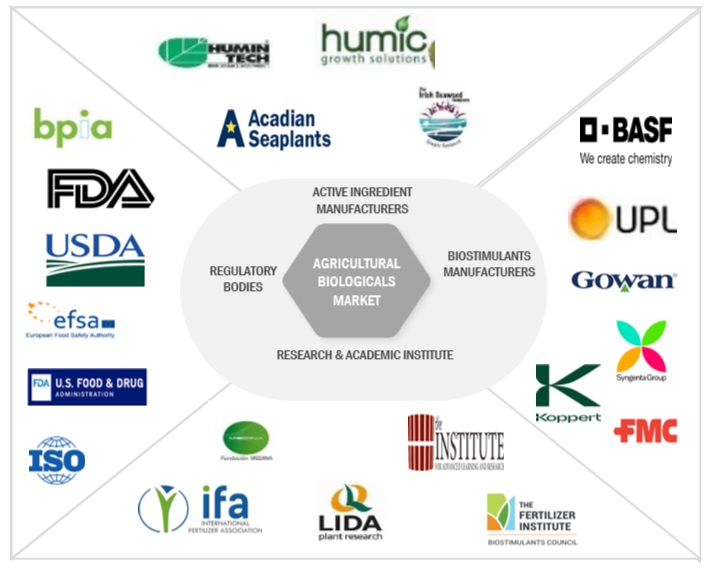
Strict regulations to drive the demand for the agricultural biologicals market
The European Union (EU) has taken a leading role in implementing strict regulations on chemical pesticides. Through the Sustainable Use Directive (2009/128/EC), the EU promotes integrated pest management (IPM) practices and encourages the utilization of non-chemical methods, including biological controls. As a result, there has been a substantial reduction in the use of chemical pesticides within European agriculture, with an increased adoption of agricultural biologicals.
Similarly, the United States Environmental Protection Agency (EPA) has been actively revising its pesticide regulations to prioritize the safety of human health and the environment. The EPA has phased out or imposed restrictions on several chemical pesticides, particularly those posing significant risks. This regulatory approach has created opportunities for agricultural biologicals to emerge as safer alternatives. Notably, biopesticides like Bacillus thuringiensis (Bt) have gained popularity as effective substitutes for chemical insecticides.
Government initiatives are driving the market growth of agricultural biologicals globally
In the United States, the USDA has implemented programs such as the Environmental Quality Incentives Program (EQIP). EQIP provides financial assistance to farmers for implementing conservation practices, including the utilization of agricultural biologicals. Additionally, the Conservation Stewardship Program (CSP) offers incentives to farmers who adopt and maintain sustainable agricultural practices, such as the use of biopesticides and biofertilizers. Similarly, the European Union has implemented support mechanisms to promote sustainable agriculture and the adoption of agricultural biologicals. Through the Common Agricultural Policy (CAP), farmers are eligible for financial incentives, subsidies, and grants when they adopt environmentally friendly practices, including the incorporation of biocontrol agents and biofertilizers. Additionally, the EU's Horizon 2020 program supports research and innovation projects focused on sustainable agriculture, including the development and advancement of agricultural biologicals.
These initiatives reflect the commitment of governments to encourage the use of agricultural biologicals and sustainable farming practices. By providing financial assistance, incentives, and research funding, governments aim to facilitate the adoption of these environmentally friendly alternatives, contributing to the growth and development of the agricultural biologicals market.
North America is expected to dominate the market during the forecast period
The agricultural biologicals market has seen significant growth in North America, primarily due to the high level of awareness and willingness among farmers in the United States and Canada to adopt sustainable agricultural practices. Farmers in these regions have recognized the increasing demand for organic and sustainable food, as well as the concerns surrounding chemical pesticide use. Consequently, they have actively sought alternatives such as agricultural biologicals, which has fueled market growth.
North America also benefits from well-established distribution networks and marketing channels for agricultural inputs. The presence of established agricultural input suppliers, including distributors and retailers, has played a crucial role in making agricultural biologicals easily accessible and readily available to farmers. This streamlined distribution system has further facilitated the growth of the agricultural biologicals market in the region.
The headquarters of key players such as Corteva Agriscience (US), Pro Farm Group Inc. (US), Valent BioSciences LLC (US) makes it a significant region in the agricultural biologicals market.
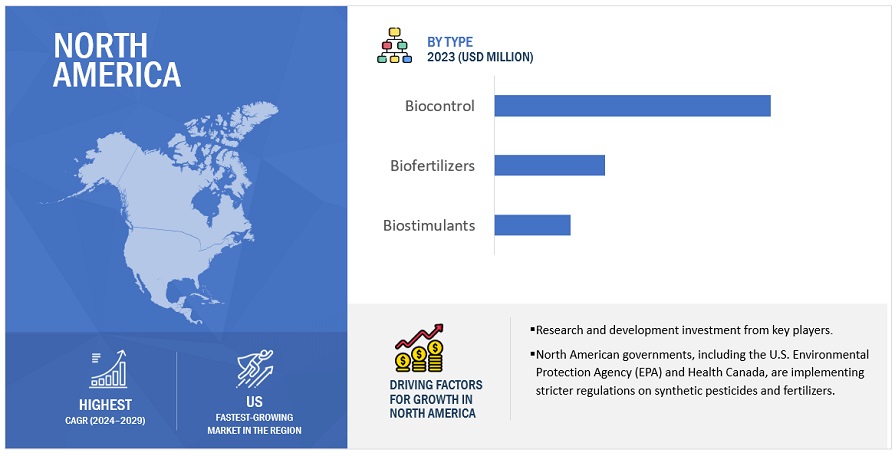
Key Market Players
The key players in this include BASF SE (Germany), Syngenta AG (Switzerland), Bayer AG (Germany), UPL (India) and Corteva Agriscience (US). These players in this market are focusing on increasing their presence through agreements, partnerships, acquisitions, and collaborations. These companies have a strong presence in North America, Asia Pacific, and Europe. They also have manufacturing facilities along with strong distribution networks across these regions.
Get online access to the report on the World's First Market Intelligence Cloud
- Easy to Download Historical Data & Forecast Numbers
- Company Analysis Dashboard for high growth potential opportunities
- Research Analyst Access for customization & queries
- Competitor Analysis with Interactive dashboard
- Latest News, Updates & Trend analysis
Request Sample Scope of the Report
Get online access to the report on the World's First Market Intelligence Cloud
- Easy to Download Historical Data & Forecast Numbers
- Company Analysis Dashboard for high growth potential opportunities
- Research Analyst Access for customization & queries
- Competitor Analysis with Interactive dashboard
- Latest News, Updates & Trend analysis
Report Metric |
Details |
Market size estimation |
2018–2028 |
Base year considered |
2022 |
Forecast period considered |
2023–2028 |
Units considered |
Value (USD) and Volume (KT) |
Segments Covered |
By Function, By Mode of Application, By Product Type, By Crop Type, and By Region |
Regions covered |
North America, South America, Europe, Asia Pacific, and Rest of the World |
Companies studied |
|
Get online access to the report on the World's First Market Intelligence Cloud
- Easy to Download Historical Data & Forecast Numbers
- Company Analysis Dashboard for high growth potential opportunities
- Research Analyst Access for customization & queries
- Competitor Analysis with Interactive dashboard
- Latest News, Updates & Trend analysis
Request Sample Scope of the Report
:
Get online access to the report on the World's First Market Intelligence Cloud
- Easy to Download Historical Data & Forecast Numbers
- Company Analysis Dashboard for high growth potential opportunities
- Research Analyst Access for customization & queries
- Competitor Analysis with Interactive dashboard
- Latest News, Updates & Trend analysis
Agricultural Biologicals Market:
By Function
- Crop Protection
- Biocontrol
- Crop Enhancement
- Biofertilizers
- Biostimulants
By Product Type
- Microbials
- Macrobials
- Semiochemicals
- Natural Products
By Mode of Application
- Foliar Spray
- Seed Treatment
- Soil Treatment
By Crop Type
- Cereals & Grains
- Oil seeds & Pulses
- Fruits & Vegetables
- Other Crop Types
By Region
- North America
- Europe
- Asia Pacific
- South America
- Rest of the World (RoW)
Recent Developments
- In July 2023, A distribution agreement for the product Essen'ciel for the Italian and Spanish markets was signed by BASF and Vivagro, a cutting-edge French firm specializing in agroecological solutions. Based on sweet orange essential oil, Essen'ciel is a natural fungicide, pesticide, and acaricide. Vine grapes, vegetable crops, berries, ornamental crops, industrial crops, and arboriculture are among the organic uses that have been allowed for it. Given the lack of insecticide alternatives, Essen'ciel stands as an alternative biocontrol agent, particularly for pip fruits like apples, pears, and quinces.
- In January 2022, In a strategic move, Syngenta Crop Protection AG has completed the acquisition of Bionema Limited's advanced bioinsecticides, namely NemaTrident and UniSpore. These cutting-edge biocontrol solutions offer customers additional and complementary technologies to efficiently and sustainably combat insect pests and address issues of resistance. With this acquisition, NemaTrident and UniSpore become the first fully owned biocontrol products in Syngenta Professional Solutions' portfolio.
Frequently Asked Questions (FAQ):
Which are the major companies in the agricultural biologicals market? What are their major strategies to strengthen their market presence?
The key players in this include BASF SE (Germany), Syngenta AG (Switzerland), Bayer AG (Germany), UPL (India), and Corteva Agriscience (US). Players involved in this market are emphasizing on agreements, partnerships, acquisitions, and collaborations as well as launching of new products in order to expand their businesses and their market shares.
What are the drivers and opportunities for the Agricultural Biologicals market?
The agricultural biologicals market is driven by several factors. Increasing consumer demand for sustainable and organic food, stricter regulations on chemical pesticides, and a growing awareness of the potential health and environmental impacts of pesticides are driving the adoption of agricultural biologicals. This creates opportunities for market growth, technological advancements, expansion into emerging markets, and collaborations between stakeholders to develop innovative and effective biological solutions for pest management in diverse cropping systems.
Which region is expected to hold the highest market share?
The market in North America is expected to have the largest market share in 2023, showcasing strong demand for organic food products in the region. Consumer demand for organic and sustainable food is driving the preference for agricultural biologicals in North America due to their compliance with organic certification standards and promotion of sustainable farming practices.
Which are the challenges that could restrict market growth of the agricultural biologicals market?
Price or Cost, efficacy, and awareness are some of the challenges that could restrict the market growth.
What is the total CAGR expected to be recorded for the agricultural biologicals market during 2023-2028?
The agricultural biologicals market is expected to record a CAGR of 13.8 % during the period 2023-2028. .
To speak to our analyst for a discussion on the above findings, click Speak to Analyst
This research involves the extensive use of secondary sources; directories; and databases (Bloomberg and Factiva) to identify and collect information useful for a technical, market-oriented, and commercial study of the agricultural biologicals market. In-depth interviews were conducted with various primary respondents, such as key industry participants, Subject Matter Experts (SMEs), C-level executives of key market players, and industry consultants, to obtain and verify critical qualitative and quantitative information and to assess prospects.
Secondary Research
In the secondary research process, various sources, such as the Food and Agricultural Organization (FAO), United States Department of Agriculture (USDA), U.S. Department of Agriculture (USDA), World Bank, and other sources were referred to identify and collect information for this study.
In the secondary research process, various sources such as annual reports, press releases & investor presentations of companies, white papers, food journals, certified publications, articles from recognized authors, gold & silver standard websites, directories, and databases, were referred to identify and collect information. Secondary research was mainly used to obtain key information about the industry’s supply chain, the total pool of key players, and market classification and segmentation as per the industry trends to the bottom-most level, regional markets, and key developments from both markets- and technology-oriented perspectives.
Primary Research
Various sources from the supply and demand sides were interviewed to obtain qualitative and quantitative information in the primary research process. The primary sources from the supply side included industry experts such as CEOs, vice presidents, marketing directors, technology and innovation directors, and related key executives from various key companies and organizations operating in the agricultural biologicals market.
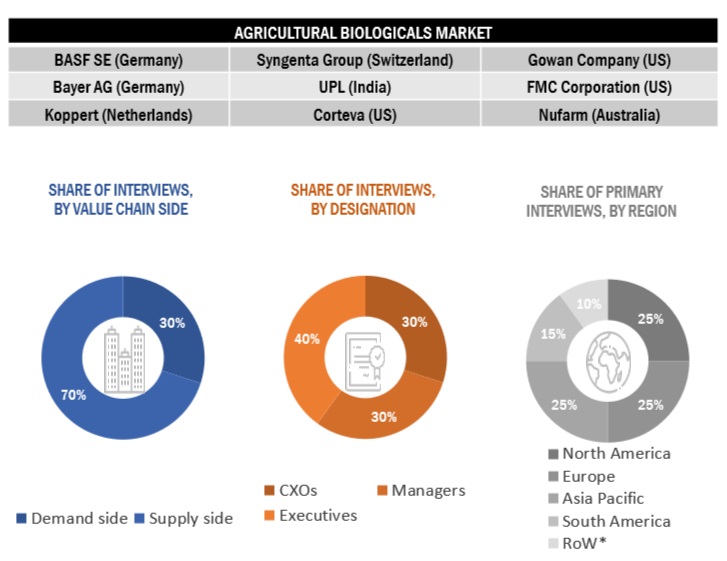
To know about the assumptions considered for the study, download the pdf brochure
Market Size Estimation
Both the top-down and bottom-up approaches were used to estimate and validate the total size of the agricultural biologicals market. These approaches were also used extensively to determine the size of various subsegments in the market for the base year, 2022.
Approach One (Based On Function, By Region)
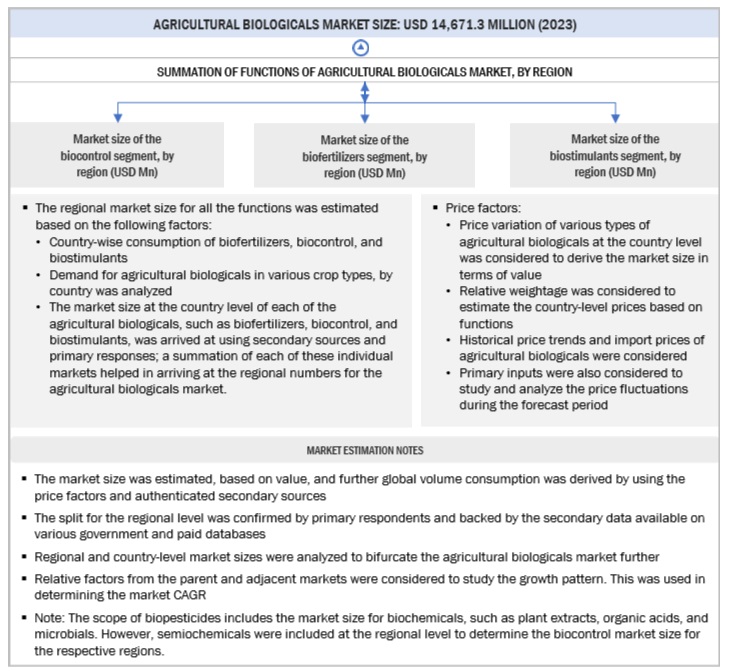
To know about the assumptions considered for the study, Request for Free Sample Report
Approach Two (Based On The Global Market)

Data Triangulation
After arriving at the overall market size from the estimation process explained above, the total market was split into several segments and subsegments. The data triangulation and market breakdown procedures were employed, wherever applicable, to estimate the overall agricultural biologicals market and arrive at the exact statistics for all segments and subsegments. The data was triangulated by studying various factors and trends from the demand and supply sides. Along with this, the market size was validated using both the top-down and bottom-up approaches.
Market Definition
According to the European Biostimulants Industry Council (EBIC), “plant biostimulants contain substance(s) and/or microorganisms whose function, when applied to plants or the rhizosphere, is to stimulate natural processes to enhance/benefit nutrient uptake, nutrient efficiency, tolerance to abiotic stress, and crop quality.”
The definition of biostimulants is largely imprecise. In many instances, an ambiguity exists between biostimulants and biofertilizers. Though organizations such as EBIC have proposed definitions, they are yet to be considered by the government regulatory bodies such as the European Union (EU) and the US Department of Agriculture (USDA).
Though derived from natural sources, the active ingredients used in the formulation range from humic and fulvic acids to amino acid and microbial amendments.
Key Stakeholders
- Manufacturers, importers & exporters, traders, distributors, and suppliers of biologicals kits, equipment, reagents, chemicals, and other related consumables
- Biological’s laboratories and associations
- Biological Products Industry Alliance (BPIA)
- The Fertilizer Institute
- Food raw material suppliers
- Food ingredient, intermediate, and end-product manufacturers and processors
- Government, research organizations, and institutions
- World Health Organization (WHO)
- Codex Alimentarius Commission (CAC)
- Regulatory bodies
- Food and Agriculture Organization (FAO)
- US Department of Agriculture (USDA)
- Biopesticide Industry Alliance (BPIA)
- International Biocontrol Manufacturers Association (IBMA)
- Japan Biocontrol Association
- US Environmental Protection Agency (US EPA)
- Commercial Research & Development (R&D) institutions and financial institutions
- Regulatory bodies, including government agencies and NGOs
Report Objectives
Market Intelligence
- To determine and project the size of the agricultural biologicals market with respect to the function, product type, mode of application, crop type, form, and region, over five years, ranging from 2023 to 2028
- To identify the attractive opportunities in the market by determining the largest and fastest-growing segments across the key regions
- Providing detailed information about the key factors influencing the market growth (drivers, restraints, opportunities, and industry-specific challenges)
- Providing the regulatory framework for major countries related to the agricultural biologicals market
- To analyze the demand-side factors based on the following:
- Impact of macro-and micro-economic factors on the market
- Shifts in demand patterns across different subsegments and regions
Competitive Intelligence
- To identify and profile the key market players in the agricultural biologicals market
- To determine the market share of key players operating in the agricultural biologicals market
- To provide a comparative analysis of the market leaders based on the following:
- Product offerings
- Business strategies
- Strengths and weaknesses
- Key financials
- To understand the competitive landscape and identify the major growth strategies adopted by players across the key regions
- To provide insights on key product innovations and investments in the global agricultural biologicals market
Available Customizations:
With the given market data, MarketsandMarkets offers customizations according to company-specific scientific needs.
The following customization options are available for the report:
Product Analysis
- Product Matrix, which gives a detailed comparison of the product portfolio of each company.
Geographic Analysis
With the given market data, MarketsandMarkets offers customizations according to company-specific scientific needs.
- Further breakdown of the Rest of the European agricultural biologicals market, by key country
- Further breakdown of the Rest of the South American agricultural biologicals market, by key country
- Further breakdown of the Rest of Asia Pacific agricultural biologicals market, by key country
Company Information
- Detailed analyses and profiling of additional market players


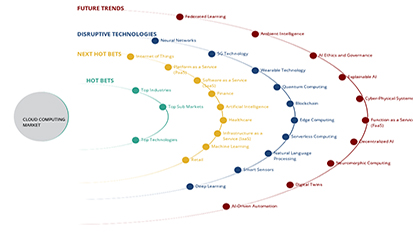

 Generating Response ...
Generating Response ...







Growth opportunities and latent adjacency in Agricultural Biologicals Market